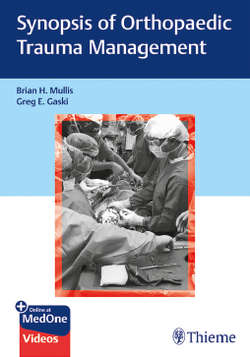Читать книгу Synopsis of Orthopaedic Trauma Management - Brian H. Mullis - Страница 71
На сайте Литреса книга снята с продажи.
IV. Orthopaedic Surgical Management
ОглавлениеA. Early appropriate care (EAC)
1. Definitive skeletal stabilization of fractures within 24 to 48 hours.
2. May be appropriate for resuscitated, physiologically stable trauma patients.
3. Decision to proceed with EAC is based on many factors, including patient overall physiologic status, number and complexity of fractures, and the patient’s tolerance of the ongoing operation.
a. Labs such as a complete blood count, lactate, pH, base deficit, and TEG may all be useful markers to gauge the patient’s physiologic state. For example, pH ≤ 7.25; BD ≥ −4; lactate ≥ 2 can all be markers that further resuscitation is required.
4. Benefits include decreased pulmonary complications and shorter intensive care unit (ICU) and hospital stay, improved mobilization.
5. Pitfalls include potential for exacerbation of lung injuries (in part from reaming of long bones) and inability to meet resuscitative demands.
B. Damage control orthopaedics (DCO)
1. Provisional stabilization of injured extremities.
2. Recognize life- and limb-threatening injuries and prioritize.
3. Terminology borrowed from US Navy—“damage control” is a way to keep vessels afloat and functional, even in the setting of severe structural damage.
4. Stabilization techniques include temporizing external fixation, provisional plate fixation, splinting, and traction application (▶Fig. 9.3a, b).
5. Pitfalls include need for additional procedures/anesthesia, and risks associated with provisional external fixation including pin tract infection.
C. Decision-making (EAC vs. DCO)
1. First, ‘Do no harm’—do not make a bad situation worse with prolonged anesthesia, surgical insult, and excessive blood loss.
2. Conversely, physiologically stable patients undergoing early definitive stabilization may benefit from improved short-term outcomes (fewer ICU days, hospital days, earlier mobilization).
3. Management of polytraumatized patients requires a multidisciplinary approach, including input from all relevant teams (ER, trauma, orthopaedic, anesthesia, critical care, neurosurgery, urology, vascular, plastics, etc.).
4. Patients with pulmonary issues including severe pulmonary contusions and high ventilator settings with difficulty maintaining oxygen saturation are candidates for DCO.
5. Patients with increased intracranial pressures secondary to intracranial hemorrhage and patients with renal failure should not be subjected to surgeries with a potential for large volume shifts and blood loss.
6. Patients with multiple extremity injuries and long bone injuries may be candidates for DCO, if they do not respond well to resuscitative efforts.
Fig. 9.3 (a, b) Index patient after emergent initial irrigation and debridement, fasciotomies, temporizing external fixation application and revascularization.
Fig. 9.4 The first hit is the inciting traumatic event, and the second hit is the definitive surgical intervention, usually femoral nailing. ARDS, adult respiratory distress syndrome; MODS, multiple organ dysfunction syndrome.
D. Sequelae and complications
1. Second hit phenomenon (▶Fig. 9.4):
a. Concept that an ill-timed secondary intervention (surgery, excessive blood loss) may induce an additional inflammatory insult which may lead to multiple organ dysfunction or acute respiratory distress syndrome.
b. It must be mitigated and accounted for in order to appropriately time and sequence surgical intervention to optimize outcome of the severely traumatized patient.
c. Multiple laboratory markers, such as hematocrit, pH, base excess, and lactate, can been used to monitor the physiologic state of the patient through this time period in order to determine appropriate clearance for definitive surgical management.
d. Immunologic markers, such as interleukin-6, have been demonstrated to be elevated in nonsurvivors.
Fig. 9.5 (a–c) Index patient after definitive fixation with percutaneous iliosacral screw fixation of his posterior pelvic ring and open reduction and internal fixation of his distal femur and tibial plateau.
2. Etiology of decompensation:
a. 50%–60% of deaths happen at the scene of trauma.
b. Roughly 30% of deaths occur within the first 24 hours after arrival to a trauma center and are generally the result of hemorrhage or neurologic injury.
c. The remaining 20% of deaths occur after the first 24 hours of hospitalization as a result of infection, multiple organ dysfunction syndrome (MODS), neurologic injury, or ongoing hemorrhage. As 24-hour survival rates have improved over the last decade, the incidence of multiple organ failure has risen.
d. There is a complex interplay between the initial systemic inflammatory response to trauma and the body’s counter anti-inflammatory response, and a balance must be struck to optimize clinical resolution.
e. The role of the orthopaedic surgeon is vital to the initial stabilization effort and the decision between DCO and EAC can easily swing the pendulum between survival and morbidity and mortality. Thoughtful consideration of the patient’s overall status is paramount when planning surgical intervention (▶Fig. 9.5).
3. Nosocomial infection:
a. Occur in up to 30% of multiple-injury patients.
b. Include pneumonia, urinary tract infection, bloodstream infection, wound infection, and Clostridium difficile infection.
c. Multiple organ failure is leading cause of death in multiple-injury patients that survive the initial insult.
